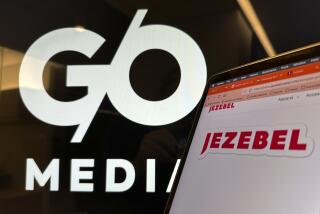Playboy gives social website the college try
chicago -- Playboy is heading back to school to boost the bottom line.
Riding a wave of renewed popularity among consumers around the globe, Hugh Hefner’s Playboy empire is set to launch a sexy social networking site dedicated solely to college students, its latest online venture as it tries to reinvigorate its stagnant finances.
The launch of Playboy U, which has similar features to those found on Facebook, comes as Playboy’s 54-year-old magazine continues to lose money and readers.
To compensate, Chicago-based Playboy Enterprises Inc. is embarking on one of its biggest expansion efforts in years.
“This is one brand that is relevant to 18- through 81-year-olds,” said Scott Stephen, executive vice president of operations for Playboy’s entertainment division. “We’re looking at this as a way to introduce and escort someone through their adult life.”
Playboy executives hope Playboy U will help build brand loyalty among young consumers.
Backed by a hit cable TV show featuring Hefner’s three girlfriends, a Sirius Satellite Radio channel and the adoration of young Hollywood stars who are again flocking to parties at the Playboy Mansion in Holmby Hills, the company is trying to grow its licensing business and online presence and build an international audience that includes a surprising legion of female fans.
Thanks in part to those initiatives, Playboy is gradually returning to profitability after years of operating in the red.
Last year the company eked out a $2.3-million profit, its second-best since posting a $47.6-million loss in 2000.
But growth has been slow as Playboy wrestles with other struggling units, such as its domestic television business, which is facing increasing competition and losing favor to other video-on-demand offerings.
“They definitely haven’t had the blowout kind of success that you would expect a big brand like Playboy to have,” said Rick Munarriz, a senior analyst at investment advisory service Motley Fool. “The brand seems to be having some kind of renaissance around the world, yet, financially speaking, it’s not really contributing to the top and bottom line.”
The latest statistics compiled by the Audit Bureau of Circulations show the magazine’s average paid circulation has fallen to just under 2.9 million readers, fewer than half of the 6.25 million who bought the magazine during its heyday in 1974. During the first six months of the company’s current fiscal year, the magazine unit lost $4.7 million, 15% more than a year earlier.
Playboy executives said there were no plans to eliminate the publication, even as the company turned its attention to other parts of the empire that include Playboy-themed casinos, clubs and apparel. Next month, Playboy will open its ninth retail store.
After resurrecting its nightclubs last fall with the Playboy Club at the Palms Casino and Resort in Las Vegas, the company is building “location-based entertainment venues.” A 40,000-square-foot Playboy Mansion in Macao will open in late 2009, and Playboy is eyeing similar projects in London, Atlantic City, Mexico and the Caribbean.
Executives declined to say how much they’ve invested in Playboy U, saying only that the effort was sizable and that the advertising-supported online community might ultimately bring in revenue.
But when and how long that will take is anyone’s guess, especially as more companies flock to compete with industry heavyweights Facebook and MySpace for the attention of fickle young people. The website has managed to get 2,000 members from 500 colleges in early beta tests.
The site bars nudity but leaves little to the imagination with pictures from the mansion’s Midsummer Night’s Dream party and message topics such as “What Do You Think About Penis Enlargement?” and “How Many People Have You Slept With? To Lie or Not to Lie.”
The site has instituted a college-only policy, which bars anyone without an e-mail address ending in “.edu” from joining.
More to Read
Inside the business of entertainment
The Wide Shot brings you news, analysis and insights on everything from streaming wars to production — and what it all means for the future.
You may occasionally receive promotional content from the Los Angeles Times.










